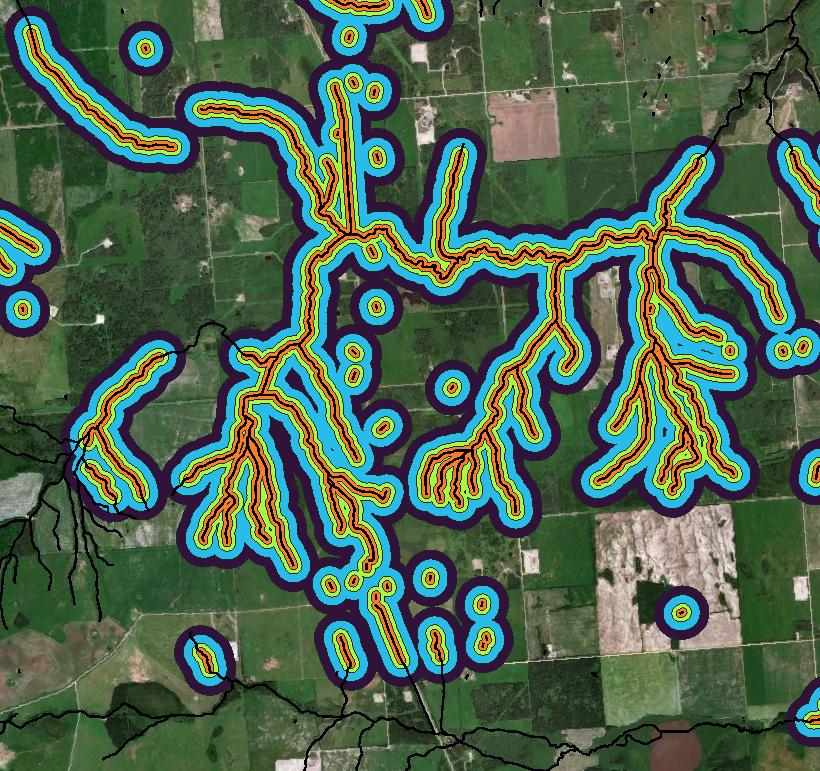I have created a ring buffer of lines (streams). I then use ST_Intersect and ST_Difference/ST_Intersects to intersect a linestring (linestring_feature) with the ring buffer (MultiPolygon) and also find the linestring segments that don't intersect with the ring buffers. The size of the analysis is relatively small, with the linestring being just 492 segments and the polygon having 4 multipolygon features. I suspect the lengthy time of 4 min 45 sec is because of the ring buffer being a large multipolygon agglomeration, but not sure how one goes about separating the unconnected ring buffer features.
Buffering SQL Code:
-- << Stream Buffer >>
CREATE TABLE stream_buffer AS
WITH bounding_box AS ( -- create a buffered bounding box (envelope) around linstring of interst
SELECT ST_Buffer(ST_Transform(ST_Union(ST_Envelope(p.geom)), 3005), 250) as geom
FROM public.linestring_feature p
),
streams AS ( -- intersect streams with envelope
SELECT ST_Intersection(b.geom, ST_Transform(s.geom, 3005)) as geom
FROM bounding_box b, public.streams_test s
), -- begin creating buffer rings
buffer50 AS(
SELECT 1.0::float8 vul, -- vulnerability value of 1.0
ST_Buffer(ST_Transform(ST_Union(geom),3005),50) geom
FROM streams),
buffer100 AS
(SELECT 0.75::float8 vul, -- vulnerability value of 0.75
ST_Difference(ST_Buffer(ST_Transform(ST_Union(geom),3005),100),ST_Buffer(ST_Transform(ST_Union(geom),3005),50)) geom
FROM streams),
buffer200 AS
(SELECT 0.50::float8 vul, -- vulnerability value of 0.50
ST_Difference(ST_Buffer(ST_Transform(ST_Union(geom),3005),200),
ST_Buffer(ST_Transform(ST_Union(geom),3005),100)) geom
FROM streams),
buffer300 AS
(SELECT 0.25::float8 vul, -- vulnerability value of 0.25
ST_Difference(ST_Buffer(ST_Transform(ST_Union(geom),3005),300),
ST_Buffer(ST_Transform(ST_Union(geom),3005),200)) geom
FROM streams)
SELECT * FROM buffer50 -- union all buffers
UNION
SELECT * FROM buffer100
UNION
SELECT * FROM buffer200
UNION
SELECT * FROM buffer300;
ALTER TABLE public.stream_buffer ADD COLUMN id SERIAL PRIMARY KEY; -- add id column
CREATE INDEX stream_buffer_geom_idx ON public.stream_buffer USING GIST (geom); -- create spatial index
Line Intersection code:
CREATE TEMP TABLE intersected AS
SELECT s.vul, ST_Intersection(p.geom, s.geom) AS geom
FROM
public.linestring_feature p,
public.stream_buffer s;
-- << Intersected linestring_feature segments outside of buffer >>
CREATE TEMP TABLE inter_nonbuffer AS
SELECT ST_Difference(l.geom, ST_Union(p.geom)) AS geom
FROM
public.linestring_feature AS l
JOIN public.stream_buffer AS p ON
ST_Intersects (l.geom, p.geom)
GROUP BY l.geom;
ALTER TABLE inter_nonbuffer -- add values of linestring_feature
ADD COLUMN vul float8;
UPDATE inter_nonbuffer
SET vul = 0.0;
SELECT * FROM inter_nonbuffer;
-- << Non intersected linestring_feature sections >>
CREATE TEMP TABLE non_intersect AS
SELECT
p.id, p.geom, s.vul
FROM
public.linestring_feature AS p
LEFT JOIN
public.stream_buffer AS s ON
ST_Intersects(p.geom,s.geom)
WHERE s.id IS NULL;
UPDATE non_intersect -- insert values of linestring_feature
SET vul=0.0
WHERE vul IS NULL;
CREATE TABLE public.strm_vul AS -- create final linestring_feature table
SELECT i.geom, i.vul FROM intersected i
UNION
SELECT ni.geom, ni.vul FROM inter_nonbuffer ni
UNION
SELECT nb.geom, nb.vul FROM non_intersect nb;
ALTER TABLE public.strm_vul ADD COLUMN id SERIAL PRIMARY KEY; -- add id column
Final intersected and nonintersected linestring features:


